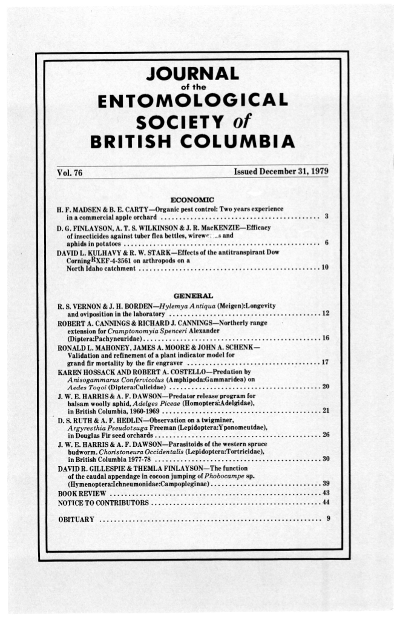<i>Hylemya antiqua</i> (Meigen): Longevity and oviposition in the laboratory?
Keywords:
<i>Hylemya antiqua</i>Abstract
In laboratory cultures, some female <i>Hylemya antiqua</i> (Meigen) were still alive and ovipositing after 66 days, whereas males usually survived no longer than 50 days. The average lifespan of 12 individually-reared, reproducing females was 48 days. Oviposition began no earlier than 8 days, and on the average, 10.5 days after the females emerged. Heavy oviposition by most females was cyclic, occurring every other day. The mean fecundity/female in 3 cultures was 259.2, 114.5 and 218.4, respectively, but for individually-reared females, it was 491.5. Variations in diet and environment probably lead to poor or inconsistent correlation of laboratory data on longevity and fecundity with actual events in the field. However, these data provide precise guidelines for utilization of <i>H. antiqua</i> in laboratory experiments.References
Allen, W.R. and W.L. Askew. 1970. A simple technique for mass-rearing the onion maggot (Diptera: Anthomyiidae) on artificial diet. Can. Ent. 102:1554-1558.
Perron, J.P. and J. Lafrance. 1961. Notes on the life-history of the onion maggot, Hylemya antiqua (Meig.) (Diptera: Anthomyiidae) reared in field cages. Can. Ent. 93:101-106.
Perron, J.P., J. Lafrance, and M. Hudon. 1953. Notes on behavior of the adult of the onion maggot, Hylemya antiqua (Meig.) in captivity. Reps. Quebec Soc. Prot. P1. (1950-1951). pp. 144-148.
Pierce, Jr., H.D., R.S. Vernon, J.H. Borden and A.C. Oehlschlager. 1978. Host selection by Hylemya antiqua (Meigen). Identification of three new attractants and oviposition stimulants. J. Chem. Ecol. 4:65-72.
Ticheler, J. 1971. Rearing of the onion fly, Hylemya antiqua (Meigen) with a view to release of sterilized insects. In: Sterility principle for insect control or eradication. (Proc. Symp., Athens, 1970). IAEA, Vienna. pp. 341-346.
Vernon, R.S., J.H. Borden, H.D. Pierce, Jr., and A.C. Oehlschlager. 1977. Host selection by Hylemya antiqua. Laboratory bioassay and methods of obtaining host volatiles. J. Chem. Ecol. 3:359-368.
Downloads
Published
Issue
Section
License
Authors who publish with the Journal of the Entomological Society of British Columbia agree to the following terms:
-Authors retain copyright and grant the journal right of first publication with the work simultaneously licensed under a Creative Commons Attribution License that allows others to share the work with an acknowledgement of the work's authorship and initial publication in this journal.
-Authors are able to enter into separate, additional contractual arrangements for the non-exclusive distribution of the journal's published version of the work (e.g., post it to an institutional repository or publish it in a book), with an acknowledgement of its initial publication in this journal.
-Authors are permitted and encouraged to post their work online (e.g., in institutional repositories or on their website) prior to and during the submission process, as it can lead to productive exchanges, as well as earlier and greater citation of published work (See The Effect of Open Access).


